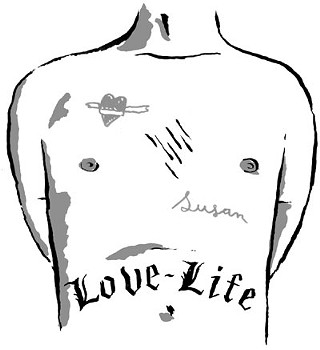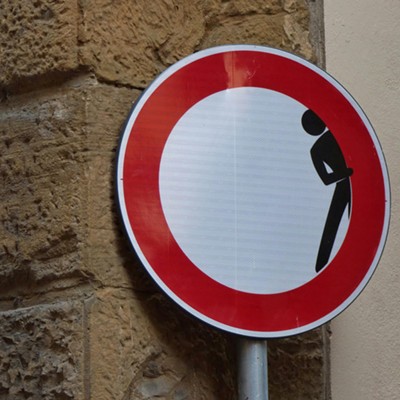Your mom will warn you against it. Your friends might, too. It really isn’t something to do on a whim. But, there may come a time in your life when you decide it’s a good idea to get the name of your honey forever emblazoned on your flesh in indelible ink.
It’s good to remember at this time of the year, in a sea of pink-bowed chocolate boxes and candy hearts, that happily-ever-after is, for many, a long shot. The statistics bear it out. And “Tammy” or “George” written in Apple Chancery font on a banner beside a heart—so poignant now—might be a painful future reminder of heartbreak, infidelity, lost innocence. It could be a monument to romance turned into a tombstone, an epitaph of happier days forever prominent on that hip, shoulder or bicep.
Note the example of those notorious romantics—professional actors—with their variety of inky issues. Johnny Depp had “Winona Forever” altered to read “Wino Forever” after his break with Ms. Ryder. Angelina Jolie removed Billy Bob Thornton from her life, then his name from her skin, though a black-ink dragon that went with it was still faintly visible at the Golden Globe awards this year, on an arm looped with Brad Pitt’s.
It’s a service Dr. Rob Miller has been offering for over a decade: the laser removal of tattoos. He does one or two treatments a week at the Dermatology Rejuvenation Centre on Coburg Road, a clinic that also offers Botox injections and a host of other cosmetic surgeries. He says he sees every kind of tattoo: Amateur tattoos and monochromatic black works are the easiest to remove, while larger, multi-coloured ones are much more difficult.
“Certain colours respond to certain lasers better than others,” he says. “For instance, the tattoo laser we have is the Nd:YAG,”—neodymium-doped yttrium aluminum garnet, also used in opthamology, dentistry, hair removal and cutting steel in manufacturing—“and that laser is good for treating black, dark blue and red. It’s like a pencil mark: You take your eraser and go through it. Each pass of the eraser over the pencil mark will remove some of the pigment. You may be lucky and remove all the pigment, or you may not.”
Repeated visits are often required. Miller charges $200 per treatment (for a toonie-sized tattoo: more for a larger one)—a 15-minute session where the beeping, coffee-table-sized laser machine is turned on, yellow goggles are worn to protect the eyes from the light radiation and a jointed mechanical arm with a plastic wand is waved over the tattoo for 10 or 15 minutes. Afterwards, the patient is sent away for the skin to heal for a month or so before the next session, if necessary. On the subject of pain, Miller says it depends on the person. “With some you have to put some freezing in,” he says. “Some people can tolerate it. There’s not usually any scarring, though there may be a little scabbing after the treatment.”
In the days before lasers, your options were more limited. There’s cell abrasion, which Miller describes as “taking salt and rubbing it into the tattoo again and again until you get down to the area that’s bleeding, then you pack it with salt,” or surgery to cut the tattoo out, if it’s small enough and in a good spot. Dr. Richard Bendor-Samuel works at the private Landings Surgical Centre and does surgical procedures on tattoos, although he recommends seeking out laser treatment first. “Surgery is your last resort, because it always leaves a scar,” he says. “The ideal tattoo is placed in an area that would be amenable to incision. What I used to tell my kids, if you’re going to have a tattoo at least make it in a place and small enough that you can cut it out if you don’t want it later. If it’s done on an ankle, there’s no way to get that out. Where you have a fleshy part that you could pinch the edges together, that’s how big your tattoo should be.”
These practical considerations rarely occur to people getting tattoos. Who goes into such a thing expecting to ever want to get rid of it, especially if it’s your darling’s name? Keep in mind, if you get it large and the laser doesn’t do the job, a skin graft may be the only answer, and as Bendor-Samuel says, “you’re trading a tattoo for a patch.”
If you are still fond of the art of tattooing, but less so of the person’s name inscribed on your chest or ass, you might consider getting another tattoo over the top. Amber Thorpe, proprietor and tattoo artist at Adept Tattoos on Quinpool Road, sees an almost daily stream of people coming in for a “cover-up.” Of course, Thorpe and her staff also get regular requests from people wanting the names of lovers on their bodies.
“Names? That happens all the time,” she says, sporting a red, yellow, green and purple pin-up girl and a pool table on her right arm. “She gets his name tattooed, he sleeps with her sister. I always ask her, ‘Are you sure he’s not going to sleep with your sister?’ And she says, ‘I don’t have a sister.’ Well, OK, what about your mother? Because there are those guys who will sleep with you and your mother.” One fellow wanted to have “Ask Catherine” across his crotch. The artist at Adept refused to do it and the guy didn’t come back. “We have philosophies on that. I’m not your mom but if you’re really young we try to deter you,” says Thorpe. You have to be 18 to get a tattoo at Adept, but in Nova Scotia, the practice of tattooing isn’t regulated as it is in other provinces and there is no legal age limit for getting one.
Thorpe recalls a young guy who came in and wanted to get his girlfriend Michelle’s name tattooed on his arm. The traditional heart and banner was designed. He told the artist that he and his beloved were best friends and had been since childhood. “He basically talked into putting the tattoo on him,” says Thorpe, smiling at the memory. “He came back three weeks later, the tattoo was just healed, and he was like, ‘She dumped me. Can I get the name blacked in?’”
Thorpe is against just blacking in names on older tattoos as it goes against her creative philosophy, but she offers plenty of alternatives to cover up existing tattoos with new designs. She’s also seen people come in after laser removal with scarring as a result, but she suggests that perhaps the best approach to remove that loathed tattoo is a combination of laser removal and a creative ink cover art, to turn your “Winona” into “Wino,” and transform your broken heart into a flaming skull.
“If it’s minor scarring we can tattoo over the top of that,” she says. “That’s what some artists are saying: “Go get a few sessions and then we can work over it.”
Carsten Knox has ink, it’s true, but never got a girlfriend’s name put on his bod. Even though he was tempted. Once. He thanks all that is holy he decided against the idea.
Got ink? Send photos of your lover’s name tattoos, or creative cover-ups, to: [email protected] and we’ll post them here.














